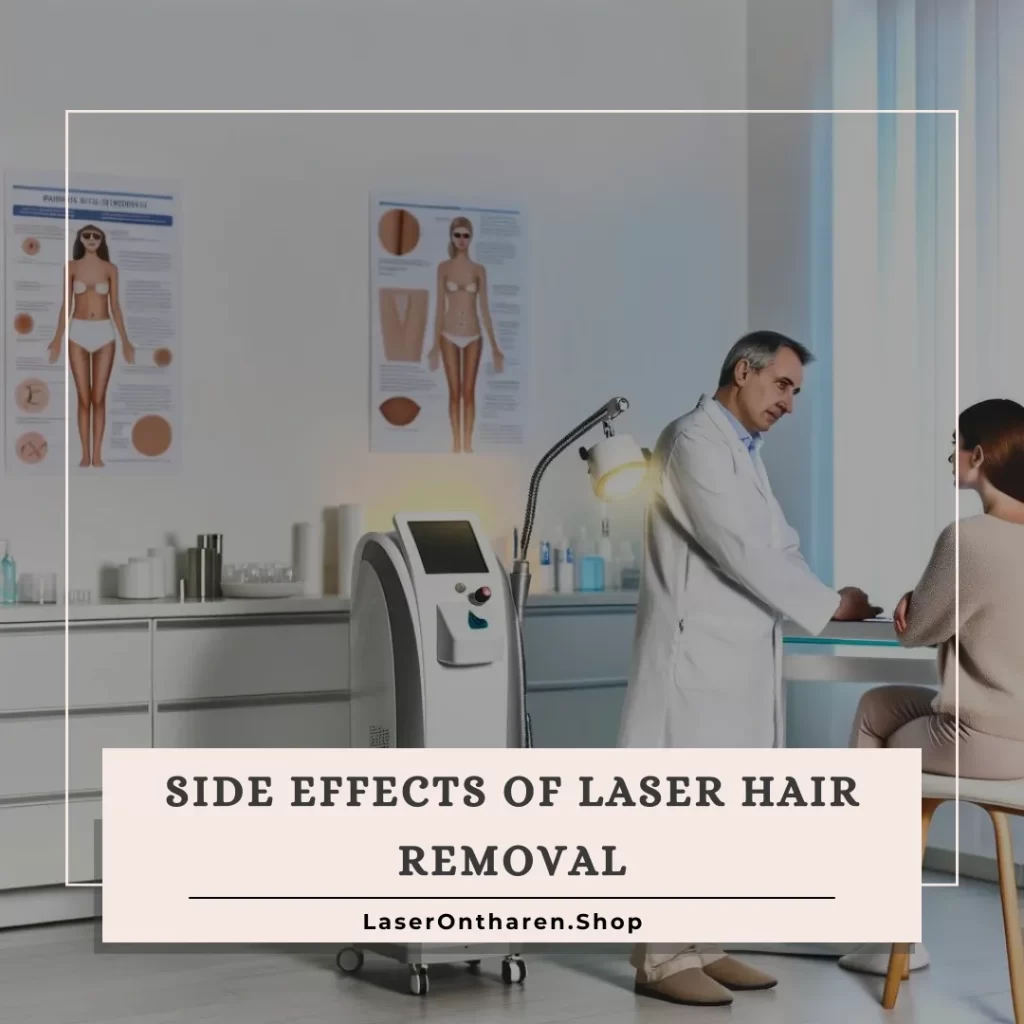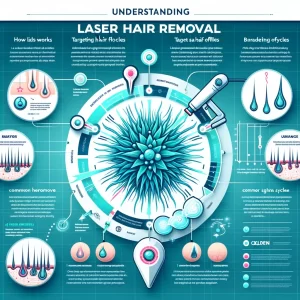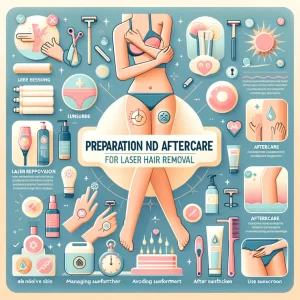Introduction: Navigating the Complexities of Laser Hair Removal
In the realm of cosmetic procedures, laser hair removal stands out for its blend of efficacy and convenience, offering a long-term solution for those seeking to reduce unwanted body hair.
As a technology-driven method, it has gained popularity for its ability to target hair follicles with precision, significantly reducing hair growth over time.
The allure of laser hair removal lies in its promise of smoother skin without the constant need for traditional hair removal methods like shaving, waxing, or plucking.
However, as with any cosmetic procedure, understanding the potential side effects is crucial for anyone considering laser hair removal.
While generally safe, the treatment isn’t free from risks, which can range from mild and temporary to rare yet serious.
The effectiveness of the procedure, along with its safety profile, greatly depends on several factors, including the skill and experience of the practitioner, the type of laser used, and the patient’s skin type and hair color.
In this article, we delve into the nuances of laser hair removal, shedding light on what potential clients can expect, the common and rare side effects associated with the procedure, and how to prepare for and recover from treatment.
Our goal is to equip you with the knowledge needed to make an informed decision about whether laser hair removal is the right choice for you, ensuring a safe and satisfying experience.
Understanding Laser Hair Removal
Laser hair removal is a cosmetic procedure that uses concentrated light to target and destroy hair follicles, the tiny sacs in our skin from which hairs grow.
The procedure hinges on the principle that the pigment (melanin) in the hair absorbs the laser light, which then converts to heat and damages the follicle, inhibiting future hair growth.
This process is most effective during the hair’s anagen phase, or growth stage, because the hair is actively growing and contains the most melanin to absorb the laser light.
How It Targets Hair Follicles
A hair follicle must be in its anagen phase for the laser to be most effective.
Hair growth occurs in cycles, including dormant phases when the hair is not actively growing.
Since not all hairs are in the same phase at any given time, multiple treatments are necessary to target as many hairs in the anagen phase as possible.
This phased approach ensures a more thorough reduction in hair growth over time.
The Importance of the Hair Growth Cycle
The cyclic nature of hair growth is why laser hair removal requires several sessions spaced out over weeks or months.
The timing between treatments is strategically planned to catch as many hairs as possible in the growth phase.
For example, areas with faster hair growth like the upper lip may need treatments every four to eight weeks, while areas with slower growth, such as the back, might have intervals of 12 to 16 weeks between sessions.
Common Side Effects
Laser hair removal is widely regarded as safe, especially when performed by a skilled and experienced practitioner.
However, it’s not without its side effects, which can vary in severity and duration.
Skin Irritation and Pigment Changes
Temporary discomfort, redness, and swelling are common immediately following the procedure, typically subsiding within a few hours.
Pigment changes, including darkening or lightening of the affected skin, may also occur.
These pigment changes are more likely in individuals who do not avoid sun exposure before or after treatment and those with darker skin tones.
While often temporary, these changes can be permanent in some cases.
Rare But Serious Side Effects
Though less common, there are more serious risks associated with laser hair removal.
These include blistering, crusting, scarring, or other changes in skin texture.
On darker skin, there is a risk of graying treated hair or excessive hair growth around treated areas.
Such complications underscore the importance of choosing a qualified practitioner for the procedure.
This detailed look into the process and effects of laser hair removal underscores its complexity and the need for professional oversight.
By understanding these aspects, potential clients can better prepare for their treatments, manage expectations, and minimize the risk of side effects.
In the next section, we will discuss how to prepare for laser hair removal and the aftercare recommendations to ensure the best possible outcomes.
Preparation and Aftercare for Laser Hair Removal
Preparing for Your Session
Preparation for laser hair removal begins well before the actual session and plays a critical role in minimizing risks and enhancing the procedure’s effectiveness.
Here are some essential steps to prepare for your treatment:
- Avoid Sun Exposure: It’s imperative to avoid sun exposure before and after treatment. Sun-tanned or sunburned skin can complicate the procedure and increase the risk of side effects.Patients are advised to use a broad-spectrum SPF30 sunscreen whenever they go out.
- Lighten Your Skin: For those with recent tans or naturally darker skin, doctors may prescribe a skin bleaching cream. This step is crucial for reducing the risk of pigment changes post-treatment.
- Cease Other Hair Removal Methods: Plucking, waxing, and electrolysis should be avoided at least four weeks before the treatment. These methods can disturb the hair follicle, reducing the laser’s effectiveness.
- Shave the Treatment Area: Shaving the area the day before your treatment is recommended. While it removes hair above the skin that could burn and cause surface damage, it leaves the hair shaft below the surface intact for the laser to target.
Aftercare Recommendations
Proper aftercare is equally important to reduce any discomfort and ensure a smooth recovery.
Following your treatment, consider these guidelines:
- Managing Discomfort: Applying ice to the treated area can help reduce redness, swelling, and discomfort.
- Avoiding Sunlight: Post-treatment, it’s crucial to avoid sunlight and not use a tanning bed for six weeks or as advised by your doctor. Continuing to use a broad-spectrum SPF30 sunscreen daily is recommended.
- Expectation Management: Hairs do not fall out immediately but will shed over days to weeks. This gradual loss may appear as continued hair growth until it progressively lessens.
Who Should Avoid Laser Hair Removal
Laser hair removal is not suitable for everyone.
Certain conditions and situations necessitate caution or outright avoidance of the procedure:
- Pregnancy: Those who are pregnant are typically advised against undergoing laser hair removal due to the lack of studies on its effects on fetal health.
- Medication and Health Conditions: Medications, especially certain acne treatments, can make the skin more sensitive to light, increasing side effects risk. Conditions like genital herpes or a propensity for keloid scars also warrant caution.
- Skin Type and Color: Laser hair removal works best on individuals with a high contrast between their hair and skin color. People with darker skin tones or lighter hair may not achieve the desired results and face a higher risk of side effects.
Conclusion
Laser hair removal offers a promising solution for those looking to reduce unwanted body hair, boasting longer-lasting results than traditional methods.
However, it comes with its share of potential side effects, from temporary discomfort to more severe risks like scarring and pigment changes.
By understanding these side effects, preparing adequately, and following aftercare instructions, individuals can significantly mitigate these risks.
Consultation with a qualified professional who can provide personalized advice based on your skin type, hair color, and medical history is essential.
Informed decisions and proper care can make laser hair removal a safe and effective choice for those seeking smoother skin.









